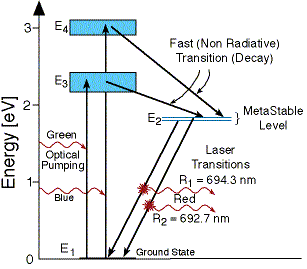- 2+
- CaZnOS基质中,devidation from a pure tetrahedral symmetry,使得spin and parity selection rule is strongly relaxed,所以发光强. [Philipe_JES_2011]
- 对任何selection rule都是禁戒。[Philipe_JES_2011]
- 多数雷达屏用的都是Mn2+激活的氟化物,它们都有长余辉(100 ms~1 s)或极长余辉(1 s 以上),比如(Zn,Mg)F2:Mn2+长余辉(橙色光),(KF, MgF2): Mn2+极长余辉(橙色光),另外还用Zn2SiO4:Mn2+,As(长余辉,绿光)。
- independent of CFS
- -为配体的时候,发红光,O2-
- 好的文章:
- luminescence is highly sensitive to the local surrounding in the host lattice and nearby defects. [Olivier_ECS_2018]
- ususally has a good thermal stability.不用校正TL. [Olivier_ECS_2018]
- 4T2
- T2能级的发射是宽带(spin-allowed),而R线(零声子线)窄带发射是spin-forbidden,是来自2
- 3Al2Ga3O12:Cr3+为例,在低温的时候(10 K)以窄带发射为主,随着温度的升高,窄带发射减弱,宽带发射增强(总积分强度反而增加,到500K),但是温度进一步升高的话,宽带发射也减弱。Temperature dependent change in PL spectra is due to thermal expansion of lattice during heating, which results in weaker crystal field of Cr3+
- Ruby激光,红宝石Al2O3:Cr3+,发射波长为694.3 nm,为最早的固体激光器材料(1960年发现)。可调谐的Cr3+掺杂激光晶体目前最好的有:
- LiCaAlF6,调谐范围为700~900 nm;
- LiSrAlF6,调谐范围为800~1010 nm;
- LiSrGaF6,调谐范围为850~950 nm;

Cr4+
Cr4+掺杂镁橄榄石(Mg2SiO4)激光器,调谐范围1350~1500 nm;Cr4+掺杂的YAG激光器,调谐范围1350~1500 nm。
参考资料:掺Cr4+离子的激光材料与器件
Ti3+
Al2O3:Ti3+钛宝石激光器,调谐范围为600~1100 nm。